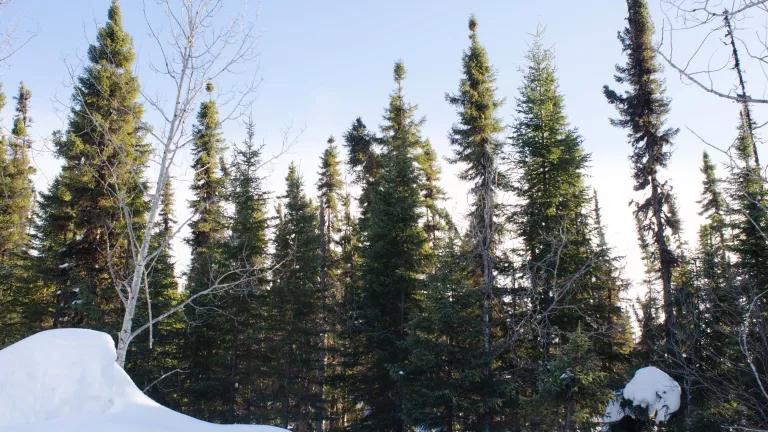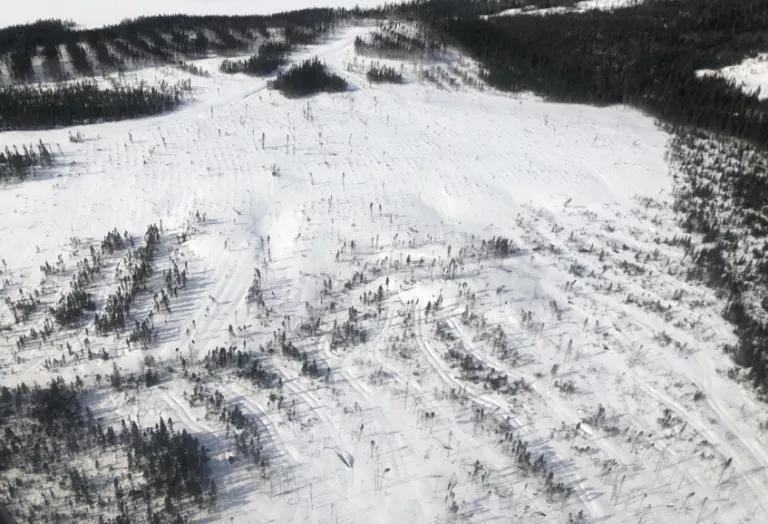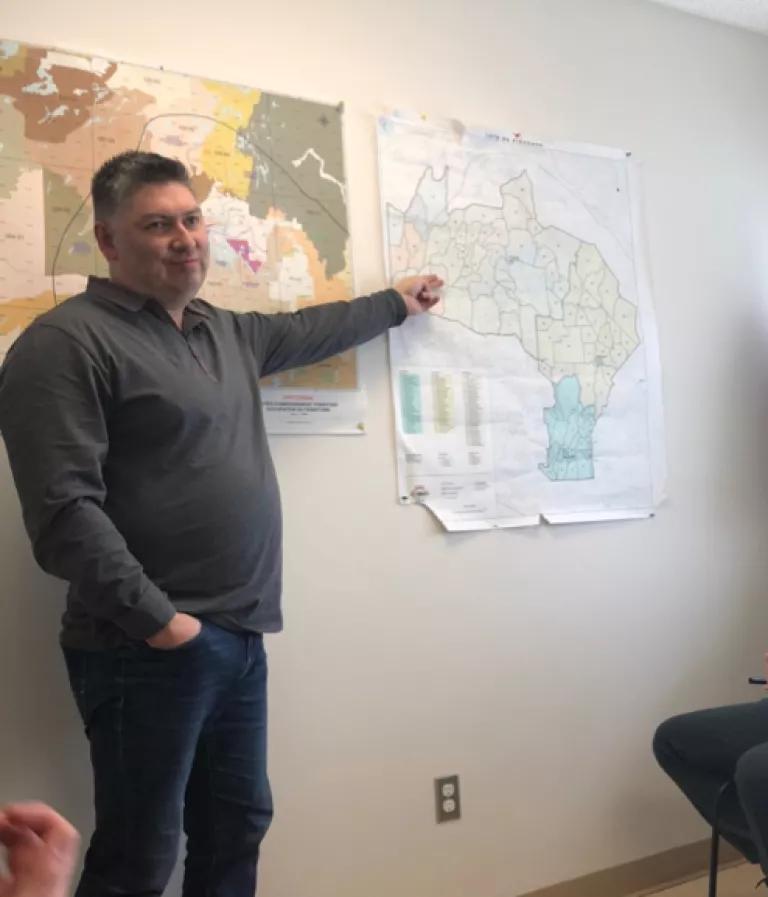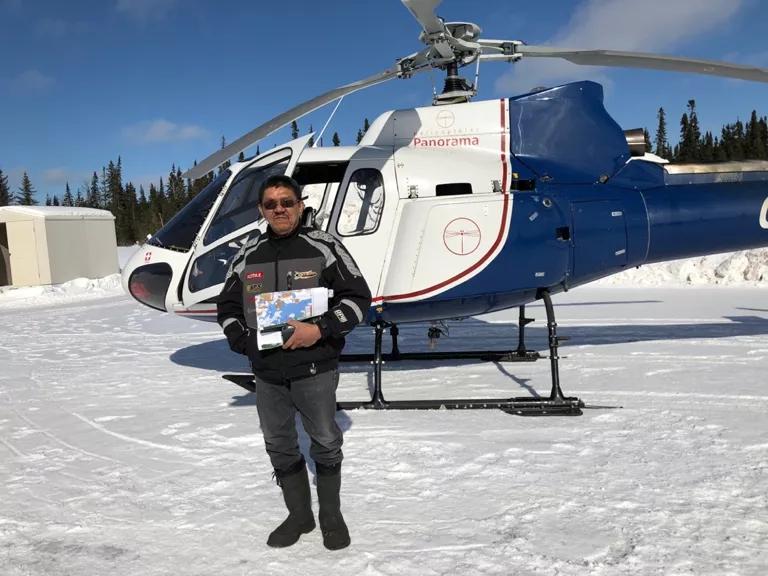
Guest blog by Jennifer Skene
Driving along the logging access roads in Atikamekw territory, the land, at first glance, appears pristine and peaceful. In mid-February, the spruce and birch trees are dusted in white, and boreal wildlife are, for the most part, unseen specters leaving ghostly tracks in the crisp snow. But, looking beyond the line of tall, majestic trees along the road, you realize it is only a few meters deep. This carefully-crafted illusion was left by logging companies to hide the fact that beyond this tableau, the forest has been stripped bare.
Logging’s Impacts on the Atikamekw Way of Life
The Atikamekw First Nation community of Opitciwan—one of three Atikamekw communities— lies a ten-hour drive northwest of Montreal. This boreal region, which the Atikamekw call Nitaskinan (“Our Land”), is in Quebec’s upper Saint-Maurice River valley. For the Atikamekw, as for so many other Indigenous communities in Canada, their way of life is inextricably tied to the boreal forest. While some community members live in the town near the Council, schools, and recreation centers, many still spend a substantial portion of the year in camps across the territory. There, they hunt animals like moose, beaver, and goose; fish for walleye; and, in August, gather blueberries. Each year, the community organizes a walk across their territory to reconnect with their land.
Yet, this way of life is being threatened by the rampant logging operations on Atikamekw territory. Opitciwan Chief Christian Awashish described that, due to logging, “there are many things that are lost: our livelihood and sustenance, the capacity to pass our culture down to the future generations.” Boreal caribou have long been absent from the region, and moose, which are central to Atikamekw culture, are declining. Meanwhile, the construction of logging roads further opens up the territory to disturbance.

While logging companies are required to regenerate the forest, the forest grows back slowly and, even years later, is rarely the same as the original intact landscape. Often, rather than replanting the spruce or birch trees originally there, companies will plant pine trees, which are faster-growing but can inhibit the regrowth of a rich understory ecosystem of lichens, mosses, and smaller plants—all essential for wildlife like moose. Even where the forest is allowed to regenerate naturally, it can take decades before the forest is anywhere close to what it was before it was logged. Particularly in the winter, with the diminutive regrowth nearly completely covered with snow, animals have no place to seek shelter.

Shut Out of Land-Use Planning
Logging operations proceed, for the most part, with little to no consultation with the Opitciwan community or the families with ancestral rights to the land. Canadian courts have recognized that Indigenous Peoples must be consulted “in good faith” about development on their land. However, in practice, this duty of consultation is often ignored. In addition, the Atikamekw receive no royalties or meaningful compensation for the loss of their resources.
The Atikamekw also have little say over what forest areas are protected—a selection process that Chief Awashish diplomatically described as “very questionable.” The little land that is protected is, for the most part, less valuable to the community and the boreal ecosystem. Chief Awashish explained, “The government chooses [protected areas] at random without really knowing the potential or the value of an area that is protected. They choose places…that are not recommended by our members, or areas that have been chosen only after logging operations.”

Safeguarding their Homeland
The Atikamekw have been fighting to protect their homeland from logging for years. In 2012, the Atikamekw communities of Opitciwan and Wemotaci erected roadblocks to stop logging operations in their territory. In September 2014, the Atikamekw Nation declared its sovereignty over 19.7 million acres of land between Montreal and Lac Saint-Jean. Shortly afterwards, the Nation announced it would not permit any logging in the region without their consent.
Most recently, the Atikamekw of Opitciwan halted a particularly destructive logging operation on some of the last intact forest of the Weizineau family, who have ancestral rights to that portion of the territory. In 2017, Quebec granted the company Groupe Rémabec permission to log a vast 200,000 cubic meters of wood on this land with the tenuous justification that a small proportion of trees in the area had fallen over due to wind. The logging, according to the Weizineau family, would harm wildlife and disrupt hunting and trapping activities for 40 to 50 years. Quebec granted this permit without consulting with the community or the Weizineau family, sending the family a letter mere weeks before the start of the project informing them that the logging would begin. The Atikamekw asked Quebec’s premier, Philippe Couillard, to halt the operations, but received no response.
As a last resort, in August 2017 the Atikamekw turned to the legal system for an injunction. In a stark display of disregard for the Atikamekw, Rémabec quickly ramped up operations as the injunction request was pending to remove as much wood as possible before the courts could act. The Weizineau family reported that Rémabec was logging for 24 hours a day with 18 machines.
The court finally granted the injunction later that month, finding that the negative impacts the Atikamekw community faced from the logging were greater than the economic impact a temporary suspension would have on Rémabec. The injunction allowed time for consultations with the Atikamekw, which resulted in a logging plan that, while still destructive, avoids some of the most vital forest areas.

A Future Guided by Indigenous-Led Planning
The Atikamekw are not opposed to all logging. In fact, they co-own and operate their own logging mill in Opitciwan. But the Atikamekw’s operations look quite different from those of the bigger, outside logging corporations. The logging area allotted to the sawmill is significantly smaller than those owned by other companies, and operations proceed much more slowly. Given the helm, the Atikamekw are able to ensure logging is done sustainably, and the community sees the economic benefits. As Chief Awashish stated, “The pressure of forestry development would not be as great as it is now…if we managed the territory ourselves.” The Atikamekw “have to maintain a balance, a habitat for animals… Our identity, our culture is more conducive to the sustainability of traditional activities [than outside logging operations].”
The Atikamekw’s care for the land illustrates the importance of allowing Indigenous communities to dictate land-use planning on their territories. While provinces and territories are failing to implement meaningful boreal forest protections, Indigenous Nations across Canada are providing models for sustainable economic development, developing land-use plans that incorporate their communities’ local needs and concerns. As Canada looks to fulfill its promises of reconciliation, commitments under the United Nations Declaration on the Rights of Indigenous Peoples (UNDRIP), and international obligation to protect 17 percent of its land by 2020, facilitating Indigenous-led protection and resource management will be essential.
Empowering Opitciwan and other communities to protect their land will enable them to create healthy, self-determined futures for their people. Chief Awashish explained that the boreal is vital to passing down traditions from generation to generation. “It is this habitat, this home that the Creator has given us, that we must take care of, and we must ensure its sustainability. This is what we want to give our children and grandchildren for a better future.” As a result, the Atikamekw will continue fighting for their territory and their way of life. “It is our identity that is at stake.”

